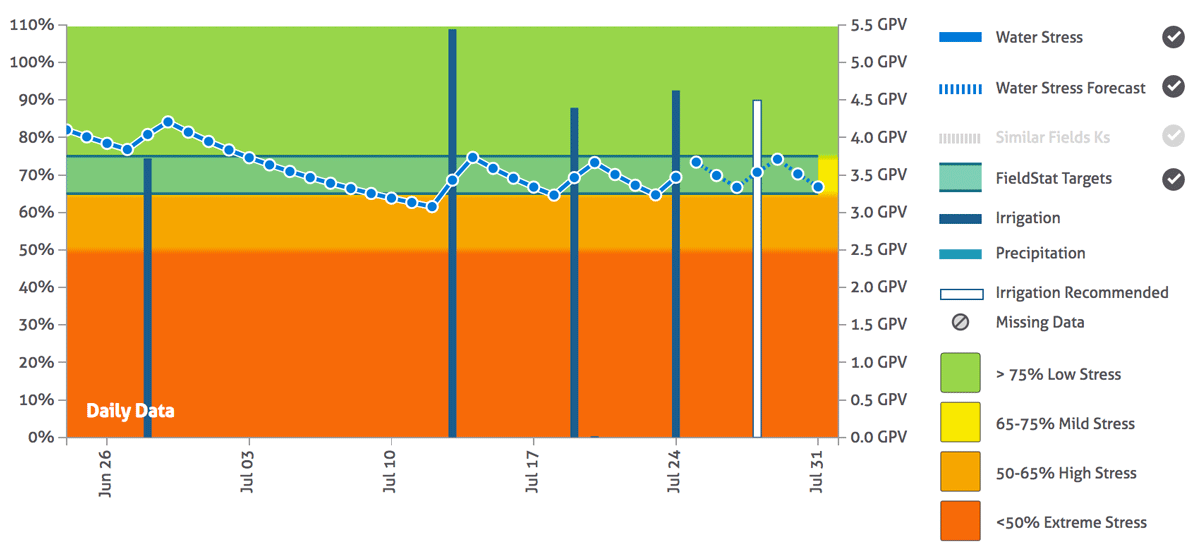We are excited to introduce to you our new FieldStat Water Stress Forecasts! The forecasts are a great leap forward in irrigation management technology for two reasons. First, the FieldStat Water Stress Forecasts provide you and our other growers with the ability to see the number of days until you need to irrigate and the influence of future irrigation applications on the water stress of the plants. This ability to see into the future is a first in the 10,000 year history of agriculture. Second, FieldStat Water Stress Forecasts are the foundation for advancing towards the future of precision agriculture. Today, we are a significant step closer to connecting the dots between each irrigation decision and the final crop yield and quality.
The Future of Water Stress Monitoring
The new FieldStat also provides forecasts of the water stress level of your plants. The forecasts tell you the number of days until the water stress level falls below your target threshold. When the forecast water stress levels fall below your target water stress levels, Tule forecasts the amount of irrigation required for the plants to recover to the desired water status. For the first time ever, you and other growers know how many days until your next irrigation event and the amount of water required for your plants to achieve your production goal.
Site-Specific, Mechanistic View of the Water Relations of Each Block
In the absence of irrigation, as plants use water, they become more water stressed. For a given amount of evapotranspiration, the amount of increase in water stress is specific to each field. The soil texture, soil structure, root depth, rootstock, scion, the size of the canopy, and a myriad of other factors influence how quickly the plant water status of a field responds to water losses and water additions. It is common to find that the water relations in two adjacent blocks differ significantly from one another. One block may become water stressed after a few days without irrigation, whereas the adjacent block takes three weeks without irrigation to reach the same stress level.We learn the site-specific water relations of each of your blocks using the data from the Tule sensors. Every day, Tule measures the most recent evapotranspiration, irrigation and Ks data from your field. Each new day of data informs our understanding of how much water is required to change the stress level of your block. In effect, FieldStat Water Stress is a model that is re-trained every day to infer the response of the plant water status to irrigation, rainfall and evapotranspiration. We use this mechanistic understanding of the water relations of your block to forecast how the upcoming atmospheric demand will translate to an increase in water stress. We use the same process to predict how future irrigation amounts will translate to a decrease in water stress.
A Breakthrough Innovation
This breakthrough innovation is a product of our proprietary evapotranspiration measurement technology and our vast dataset. Tule is the only company that can measure evapotranspiration. There are various techniques for grossly estimating evapotranspiration, but the ability to build water stress forecasts requires direct measurements of daily evapotranspiration.Moreover, Tule determines the site-specific water relations of not just a few fields, but of hundreds of fields over many years. Because our dataset includes the entire spectrum of growing conditions and production strategies, we are able to distill the general principles behind field-scale water-relations rather than drawing conclusions based on anecdotes from a few blocks. The broad range of soil, agronomic and climatic conditions in our dataset is the foundation of our forecasting capability.
The timespan of our dataset was also integral to the development of the forecasts. When we were working on the forecasts, we stepped back in time to midway through a season at a block. Next, we forecasted the water stress the remainder of the season. To guide the iteration on our forecasting methodology and assess the accuracy of the forecasts, we compared our forecast water stress to the actual water stress. Across years and blocks, there was on average a 7% FieldStat error in our forecasts.
FieldStat Water Stress Forecasts and Irrigation Recommendations

Tule’s irrigation recommendations allow the FieldStat Water Stress Forecast to reach the lower boundary of the target band. On the day when the forecast predicts that water stress will cross the lower boundary, Tule recommends the amount of water required to relieve the water stress, bringing the FieldStat Water Stress Forecast to the upper boundary of the target band.
At this particular vineyard, Tule is forecasting that the grower needs to irrigate in four days to prevent the water stress from falling below the target. On the fourth day, Tule recommends that the grower applies 4.5 gallons per vine. The application of 4.5 gallons per vine is forecasted to relieve the water stress to the upper boundary of the target water stress band.
For more information on the forecast updates to the dashboard, please see our Tule Dashboard Guide.
Initial Rollout
There are a few reasons a block may not have the forecasts enabled. We are rolling out the forecasts in stages, starting with vineyards only, so we can quickly incorporate feedback from growers. Tree crops and annuals do not have the forecast enabled at the time this post was published.The forecasts are for water-limited growing conditions. Once the plants in your block have started to slow down or cease vegetative growth, the forecasts become available.
Tule meticulously curates your data, but some circumstances are beyond our control. In the case of tractor blight and other causes of data interruption, Tule’s internal quality control processes get reset. This may temporarily delay or prevent the forecasts from becoming available. If you notice something unexpected in your data, like a missing irrigation event, please email us.
The forecasts are released as a free beta in 2017.

 By Team Tule, July 26, 2017
By Team Tule, July 26, 2017


